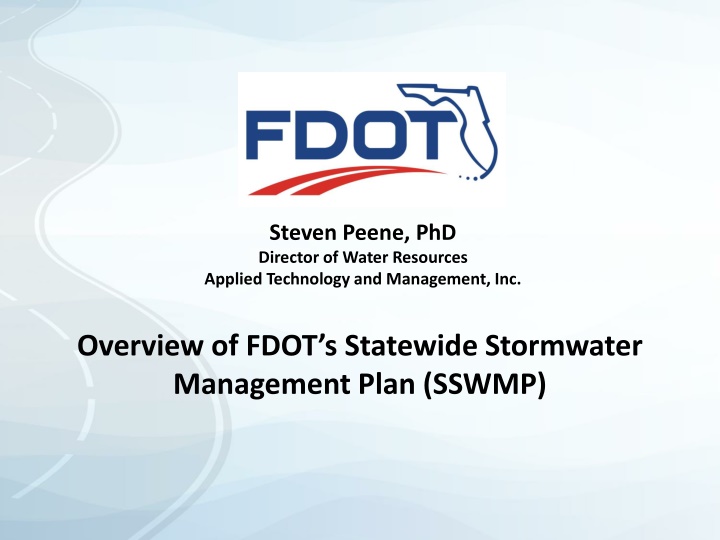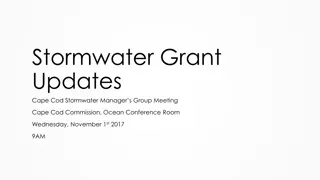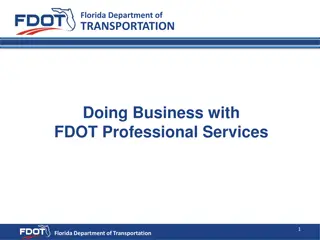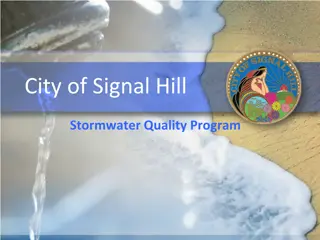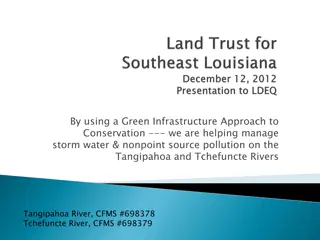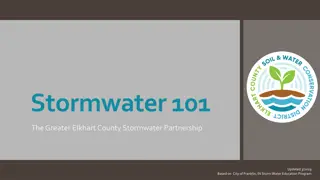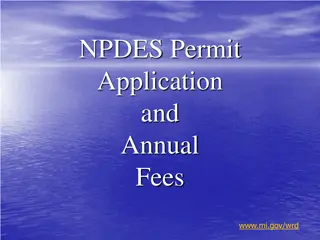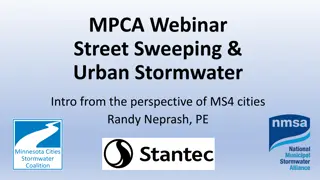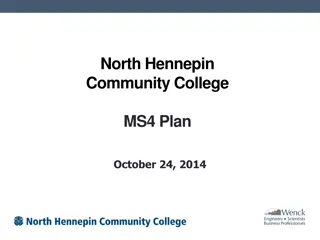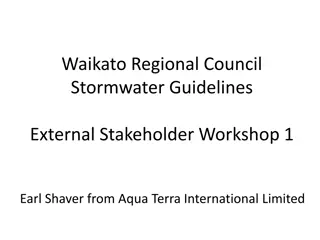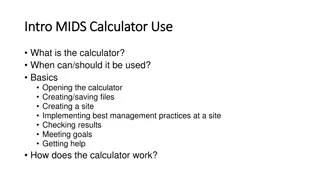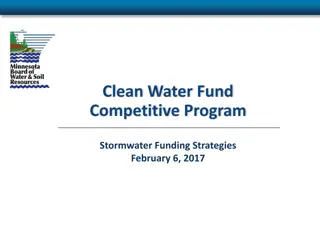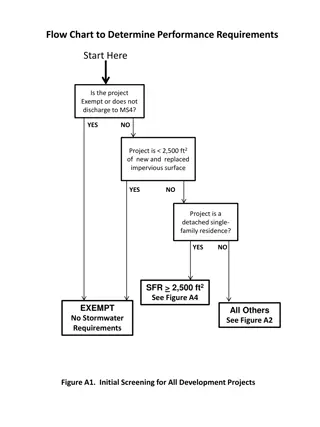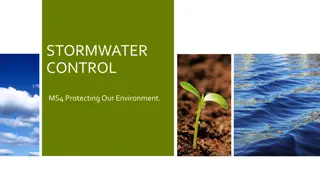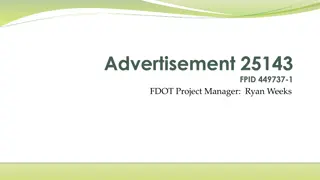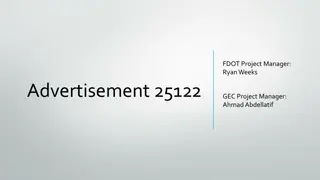FDOT's Statewide Stormwater Management Plan (SSWMP)
The Statewide Stormwater Management Plan (SSWMP) is a crucial document developed by FDOT to reduce pollutant discharge in Phase 1 MS4s. It is required under Phase I MS4 permits by FDEP's NPDES program and falls under the Clean Water Act. The SSWMP applies primarily in 15 Phase I Permit Counties but its practices are generally applied across the state. It includes various components like FDOT structure, stormwater inventory, erosion control, street sweeping, public education, and more.
Download Presentation

Please find below an Image/Link to download the presentation.
The content on the website is provided AS IS for your information and personal use only. It may not be sold, licensed, or shared on other websites without obtaining consent from the author.If you encounter any issues during the download, it is possible that the publisher has removed the file from their server.
You are allowed to download the files provided on this website for personal or commercial use, subject to the condition that they are used lawfully. All files are the property of their respective owners.
The content on the website is provided AS IS for your information and personal use only. It may not be sold, licensed, or shared on other websites without obtaining consent from the author.
E N D
Presentation Transcript
Steven Peene, PhD Director of Water Resources Applied Technology and Management, Inc. Overview of FDOT s Statewide Stormwater Management Plan (SSWMP)
What is the SSWMP and why is FDOT required to develop it? The SSWMP describes activities, methods, and procedures to reduce the discharge of pollutants from the FDOT Phase 1 MS4s The development of the SSWMP is required under Phase I MS4 permits through FDEP s NPDES program Part of the Clean Water Act
Where does the SSWMP apply? Legally, the SSWMP only applies in the 15 Phase I Permit Counties But generally, the practices are applied across the State
What is in the SSWMP? Overview of FDOT Structure , Jurisdiction, Authority, and Procedures FDOT Intergovernmental Coordination Stormwater Inventory Stormwater Facilities Inspection and Maintenance Procedures for New Construction/Development Erosion Control Street Sweeping Litter Control
What is in the SSWMP (contd)? Operations Center and Maintenance Yard Stormwater Control Application of Pesticides, Herbicides, and Fertilizers Illicit Discharge Detection and Elimination (IDDE) Response and Training Spill Response and Training Control of Construction Site Runoff Public Education Water Quality Monitoring
Stormwater Facility Inspection/Maintenance Structural Control Inspection Frequency Maintenance Frequency Wet Detention New Projects: Once per year for first 2 years. Existing System w/o Chronic Problems: Once per 3 years. Existing System w/ Chronic Problems: Once per year until fixed As needed per inspection Dry Retention New Projects: Once per year for first 2 years. Existing System w/o Chronic Problems: Once per 3 years. Existing System w/ Chronic Problems: Once per year until fixed As needed per inspection Dry Detention New Projects: Once per year for first 2 years. Existing System w/o Chronic Problems: Once per 3 years. Existing System w/ Chronic Problems: Once per year until fixed As needed per inspection Dry Detention with Filtration New Projects: Once per year for first 2 years. Existing System w/o Chronic Problems: Once per 18 months Existing System w/ Chronic Problems: Once per year until fixed As needed per inspection Exfiltration Trench/French Drain Systems New Projects: Once per year for first 2 years. Existing System w/o Chronic Problems: Once per 3 years. Existing System w/ Chronic Problems: Once per year until fixed As needed per inspection Dry Treatment Grass Swales New Projects: Once per year for first 2 years. Existing System w/o Chronic Problems: Once per 3 years. Existing System w/ Chronic Problems: Once per year until fixed As needed per inspection
Stormwater Facility Inspection/Maintenance Structural Control Inspection Frequency Maintenance Frequency Pollution Control Boxes Once per 3 months unless clean out records indicate a more or less frequent schedule is needed As needed per inspection Stormwater Pump Stations Once per 6 months As needed per inspection Major Stormwater Outfalls/Canals Once per year, unless historical operation records demonstrate that a more or less frequent schedule is appropriate. As needed per inspection Weirs and Control Structures MRP As needed per inspection Pipes and Culverts MRP As needed per inspection Inlets, Catch Basins Grates, Ditches and Other Stormwater Conveyances MRP As needed per inspection
Wet Detention Ponds 1. 2. 3. 4. 5. Remove blockages, restore drawdown capability. Remove accumulated silt. Repair erosion and cracks and remove blockages. Restore healthy grass cover on all slopes and around structures. 1. 2. 3. 4. 5. Inspect pond/control structure for proper treatment volume drawdown. Inspect pond for silt accumulation in design pond volume. Inspect inflow and outflow structures for cracks, blockages or signs of erosion. Inspect vegetation on side slopes for cover and signs of erosion. Inspect the pond for signs of exotic overgrowth and nuisance species. Remove excess growth of exotics/nuisance species if they impact hydraulic capacity or impede the proper functioning of the pond. Dispose of accumulated sediments properly. 6.
Dry Detention/Retention Ponds 1. Restore the infiltration capacity of the retention basin by scraping, discing, or otherwise aerating the basin bottom. Remove accumulated sediment from retention basin bottom and inflow pipes. Maintain healthy vegetative cover to prevent erosion. Mow as needed. Conduct repairs to prevent undercutting or piping. 1. Inspect pond for proper drawdown, signs of standing water (dead grass) longer than designed, mosquito larvae and/or reduced percolation. Inspect basin bottom for accumulation of silt, lost volume. Inspect for clogging of inflow pipes. Inspect vegetation on side and bottom slopes for proper coverage/no erosion. Remove trash and debris from inflow structures. Note signs of petroleum hydrocarbon contamination and handle appropriately. 2. 3. 4. 5. 6. 2. 3. 4.
Exfiltration Trench/French Drains 1. Conduct minor maintenance measures to restore infiltration rates to acceptable levels. Major maintenance (total rehabilitation) is required to remove accumulated sediment in most cases or to restore recovery rate when minor measures are no 1. 2. If present, inspection ports and observation wells should be checked following three days minimum dry weather for drawdown and sediment accumulation. Inspect upstream appurtenances such as sediment and oil and grit separation traps or catch basins as well as diversion weirs or boxes. longer effective or cannot be performed due to design configuration. Remove trash and debris from diversion facilities and overflow weirs. Clean out sedimentation and oil/grit separators when sediment depth approaches cleanout level and dispose of properly. Remove debris from the outfall or "smart box". 2. 3. 4.
Outfalls 1. Remove debris, litter, and sediments as needed to ensure proper operations. Properly dispose of the litter, sediments and debris collected. Repair any structural damage to assure proper operation. Maintain healthy vegetative cover to prevent erosion of banks near outfall. Ensure that discharges from outfalls are not causing erosion and sedimentation. 1. Inspect outfalls to assure they are not clogged with litter, debris or sediment and they are flowing properly. Inspect for damaged headwalls, seepage, around pipe, erosion of bank around outfall, erosion or sedimentation at outfall discharge point, and damaged or clogged riprap. Conduct minor maintenance measures to restore infiltration rates to acceptable levels. 2. 3. 4. 2.
Maintenance Yards Districts are required to develop Standard Operating Procedures (SOP) to reduce potential for introduction of pollutants to stormwater from Maintenance Yards FDOT procedures for storage, handling and disposal of hazardous materials (including fuels, herbicides, pesticides, etc.) FDOT procedures for handling and disposal of excess asphalt Identifies maintenance of documentation Identifies that annual inspections will occur
Fertilizer, Herbicides, and Pesticide Districts are required to develop Standard Operating Procedures (SOP) for the storage, handling and application of fertilizers, herbicides and pesticides FDOT policy on fertilizer is to limit application to initial periods of seeding and/or turf establishment Certification required for all FDOT personnel and contractors applying pesticides or herbicides by January 2014 FDACS Green Industry BMP Program Districts are required to keep a list of persons who are trained
